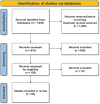A scoping review of health risks and outcomes from disasters in the Republic of Korea
- PMID: 40217450
- PMCID: PMC11987192
- DOI: 10.1186/s12889-025-22362-7
A scoping review of health risks and outcomes from disasters in the Republic of Korea
Abstract
Background: Disasters represent significant public health challenges, particularly for vulnerable populations. In the Republic of Korea, both natural and man-made disasters, exacerbated by urbanization and socioeconomic disparities, have exposed weaknesses in disaster preparedness and public health resilience. This scoping review examines health outcomes and associated risk factors from past disasters in Korea.
Methods: A comprehensive search was conducted in the PubMed, DBpia, KISS, and RISS databases for studies published between April 2004 and April 2022, following the PRISMA Extension for Scoping Reviews guidelines. Eighty-three studies met the inclusion criteria. Data were analyzed using a narrative synthesis approach to distinguish direct and indirect health effects. Key outcomes were categorized into socioeconomic, physical, mental, social, and environmental risk factors.
Results: Among the 83 reviewed studies, natural disasters accounted for 50.6% of the total, man-made disasters for 22.9%, and mass trauma events for 26.5%. Most studies (78.3%) focused on disaster survivors, with cross-sectional designs predominating (90.4%). Approximately half (51.8%) of the studies used primary data, with the remainder being based on secondary sources. Regression was the most common method for statistical analysis (75.9%). Frequently reported direct health outcomes included physical injuries such as fractures, burns, and respiratory issues, along with mental health conditions such as post-traumatic stress disorder and depression. Natural disasters were particularly associated with physical injuries, while both natural and man-made disasters had a significant impact on mental health. Vulnerable groups-older adults, women, unmarried individuals, and those with lower socioeconomic status-faced disproportionate higher risk for both physical and mental health. Indirect health impacts such as heightened anxiety, emotional distress, and weakened social cohesion were common in economically disadvantaged and disaster-prone communities, in which recovery was further hindered due to limited access to healthcare and support services.
Conclusions: These findings highlight the need for strategies aimed at disaster risk reduction that prioritize health equity, integrate mental health services, and address environmental vulnerabilities. Future research should focus on longitudinal studies to track evolving health outcomes.
Keywords: Disaster impact; Public health; Risk factors; Scoping review; Vulnerability.
© 2025. The Author(s).
Conflict of interest statement
Declarations. Ethics approval and consent to participate: This study involved a review of previously published literature and did not include any human participants or personal data. Therefore, ethics approval and consent to participate were not required. Consent for publication: Not applicable. Competing interests: The authors declare no competing interests.
Figures
Similar articles
-
Beyond the black stump: rapid reviews of health research issues affecting regional, rural and remote Australia.Med J Aust. 2020 Dec;213 Suppl 11:S3-S32.e1. doi: 10.5694/mja2.50881. Med J Aust. 2020. PMID: 33314144
-
Women's Mental Health and Intimate Partner Violence Following Natural Disaster: A Scoping Review.Prehosp Disaster Med. 2016 Dec;31(6):648-657. doi: 10.1017/S1049023X16000911. Epub 2016 Sep 19. Prehosp Disaster Med. 2016. PMID: 27641740
-
Disaster Psychiatry: An urgent field in psychiatry posing a pertinent question.Psychiatriki. 2024 Dec 27;35(4):265-268. doi: 10.22365/jpsych.2024.022. Epub 2024 Dec 15. Psychiatriki. 2024. PMID: 39688605 English, Greek, Modern.
-
Vulnerability of migrant women during disasters: a scoping review of the literature.Int J Equity Health. 2023 Jul 22;22(1):135. doi: 10.1186/s12939-023-01951-1. Int J Equity Health. 2023. PMID: 37481546 Free PMC article.
-
Effects of social support on mental health outcomes in disasters: A cross-sectional study.Nurs Health Sci. 2021 Jun;23(2):456-465. doi: 10.1111/nhs.12830. Epub 2021 Mar 31. Nurs Health Sci. 2021. PMID: 33733557
References
-
- Nomura S, Parsons AJQ, Hirabayashi M, Kinoshita R, Liao Y, Hodgson S. Social determinants of mid- to long-term disaster impacts on health: A systematic review. Int J Disaster Risk Reduct. 2016;16:53–67. 10.1016/j.ijdrr.2016.01.013.
-
- Aitsi-Selmi A, Egawa S, Sasaki H, Wannous C, Murray V. The Sendai framework for disaster risk reduction: renewing the global commitment to People’s resilience, health, and well-being. Int J Disaster Risk Sci. 2015;6(2):164–76. 10.1007/s13753-015-0050-9.
-
- World Health Organization. Health Emergency and Disaster Risk Management Framework. Geneva: World Health Organization. 2019. Available from: https://apps.who.int/iris/handle/10665/326106
-
- Ozment S, Ellison G, Jongman B. Nature-based solutions for disaster risk management: booklet. Washington. 2022.
-
- United Nations Office for Disaster Risk Reduction. Global assessment report on disaster risk reduction. Geneva: United Nations Office for Disaster Risk Reduction; 2019.
Publication types
MeSH terms
LinkOut - more resources
Full Text Sources
Medical
Miscellaneous




